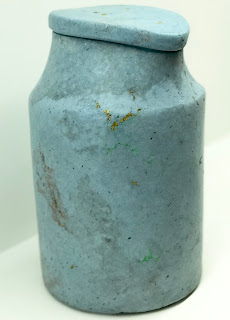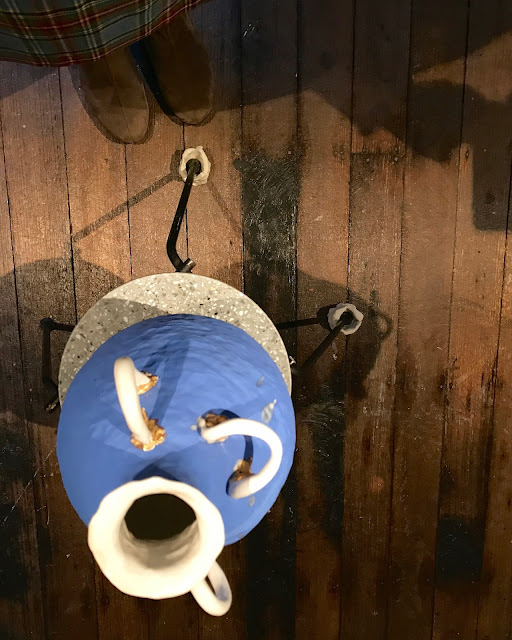A peek at how artists crafting silver, steel, polyurethane resin, enamel, wood in this exhibition exploring the possibilities of the vessel. It is a treat to see Danish ceramist Christina Schou Christensen, but sadly not her nepheline syenite slow drip works. This soft work is so engaging and the I admire decision to reveal the interior workings.
18 April - 29 May 2017
Gallery Funaki, Melbourne
 |
Christina Schou Christensen (Denmark)
Soft Fold Pink, 2013
earthenware clay, engobe, glaze
|
 |
David Clarke (United Kingdom)
Baroque Beauties, 2016
pewter
|
 |
Sally Marsland (Australia)
Vessels, 2012 -2017 polyurethane resin mixed with powdered pigment , wood |
 |
Peter Bauhuis (Germany)
Simultanea, 2016
sterling silver, fine silver
|
 |
Inari Kiuru (Finland/Australia)Heavy water (Fukushima butterflies), 2017
concrete, iron oxide, pigment, wax, mild steel, iron filings |
 |
Vito Bila (Australia)
Vessel Cluster #1, 2012
Tall vessel, stainless steel
Medium vessel, stainless steel
Small vessel, copper
|
 |
Lindy McSwan (Australia)
Fragment vessels, 2017
Char, mild steel, enamel $980 Ash, mild Steel, enamel, porcelain $980 Cinder, mild steel, enamel, porcelain slip, mica, wax |
 |
Barbara Schrobenhauser (Germany)Time is on my side - Blue like the future, 2017
paper, paste, red sand, basalt sand, green glass pigments, lichen |
 |
Marian Hosking (Australia)
Cape Conran, 2017
sterling silver |
 |
Robin Bold (Australia)
Series 3 - 1,3,7, 2012
1, silver-plated nickel (EPNS) keel on kauri plinth
3, kauri keel on stainless steel plinth7, kauri keel on nickel plinth
|
 |
David Bielander (Switzeralnd/Germany)
Paper Bag (Sugar), 2016
patinated sterling silver
|
HOLD: Exploring the Contemporary Vessel
Natasha Sutila, 2017
When we think about what it is to hold, the obvious reference to physical matter soon gives way to other contents: to hold meaning, memory, tradition or association. To hold your attention, to hold your gaze. The vessel, in its ubiquity and historical significance, serves as a powerful device for expressing concepts and provoking thought. This survey exhibition observes ways in which contemporary makers approach the vessel, particularly through the language of materiality. Looking at themes of making, narrative, value and use, HOLD considers the contemporary vessel’s potential to enrich and expand on the concept of containment.
Making
The conduct of thought goes along with, and continually answers to, the fluxes and flows of the materials with which we work. These materials think in us, as we think through them.(Ingold 2013, 6)
Social anthropologist Tim Ingold speaks of a making theory he coins as “The art of inquiry”, at odds with the hylomorphic model of the maker imposing a preconceived form onto inert matter. In these works, we see a clear embodiment of that idea. An expression formed through a dialogue with material.
The work of Peter Bauhuis exemplifies a meticulous approach to making matched with a trust and relinquishment of control. In his bi-metal casting process, Bauhuis pours one molten metal on top of the other, allowing the two to interact and form a tonal gradation directly affected by the intrinsic qualities of the alloys. The science of metallurgy becomes choreography, a dance between control and chance.
The process of making is laid bare in Sally Marsland’s work. Within this group, vessels are formed using a poured casting technique Marsland has refined in the making of her jewellery pieces. Surrounding these works are vessels that occur as byproducts of her process. Mixing pots, drip sheets and tools covered in excess, revealing the temperament and viscosity of the fast setting resin. The variety of hues, textures and volumes achieved in these works speak of Marsland’s harmony with a material as responsive as it is unruly.
The malleable and receptive nature of clay is a distinctive aesthetic feature in the work of Danish artist Christina Schou Christensen. With its undulating fleshy forms, her Soft Fold Pink vessel displays a haptic connection to material, which is both sensually raw and refined. Through her hand building process, Christensen allows the material’s plasticity to dictate how each fold lands, droops and protrudes. Rather a designed outcome, the final form acts as an artefact of the making experience.
Narrative
In understanding these vessels as objects with their own history and agency, we can unlock their narratives, cultural contexts and the relationship to their makers.
A sense of place and experience is imbued in Marian Hosking’s Cape Conran vessels. Comprising fabricated forms and cast elements taken directly from the environment, these vessels tell a story of the gatherer, retaining memories through collected souvenirs. Much like a seashell exposing its inner architecture or a native leaf revealing its venation, these vessels privilege the eye of the close and curious observer.
A similarly close attention is employed by Lindy McSwan in her Fragment vessels, focusing on the charred surfaces of native forests devastated by bushfire. McSwan emulates the changing states of burning charcoal through a finely honed enamelling technique. The assemblage of these vessels express a passing of time and a way of contemplating the overwhelming tragedy of bushfire.
Tradition and family history play a significant role in Robin Bold’s Series 3 - 1,3,7 vessels. Part of a larger work of 19 pieces, Series 3 uses the concept of family silver to explore wider narratives of migration and family lineage. The nickel, steel and kauri used in Bold’s work, directly correspond to materials prominent in her own family history of trans-Tasman migrants and seafarers. This family portrait speaks of a deeply personal relationship to material and the artist's identity as a maker.
Value
The idea of material hierarchy and value is ingrained in our cultural consciousness; from Greek Mythology’s Ages of Man, to the recurrent custom of wedding anniversary gifts. Craft tradition certainly heeds these conventions, giving contemporary makers the ability to challenge lines of thought and uncover new ways of expressing value.
Renowned for his subversion of silversmithing traditions, David Clarke uses his Baroque Beauties to question material value and ideas of form. Clarke purchased 5 candlesticks from eBay and cast each in pewter, with their packaging materials intact. The cheap and ephemeral packing is absorbed into the vessel’s permanent form, its function as a protective layer reasserted as decorative embellishment.
In an ode to the beauty of the everyday object, David Bielander fabricates and patinas sterling silver to create his Paper Bag (Sugar) vessel. The familiar and disposable form is afforded a new value, not just in its material reimagining, but in the care and attention evident in its meticulous replication. Bielander’s ability to capture the beauty of the humble paper bag, submissively battered and textured through use, proves this vessel to be so much more than just a clever juxtaposition.
The value of paper is also reconsidered by Barbara Schrobenhauser’s Time is on my side - Blue like the future vessel. Schrobenhauser creates her vessels from pulped paper mixed with various pigments and materials, pressed into specially made moulds. The deceptively lightweight vessels have a colouring and texture akin to a heavy stone, their size suggesting a ritualistic purpose. Schrobenhauser takes advantage of our material associations and assumptions to channel thoughts of time, memory and perception.
Use
The ongoing discourse surrounding function and the craft object’s tie to it, are no less present in these contemporary works. In her essay “The Maker’s Eye”, British ceramicist Alison Britton (1982, 442) contemplates the distinction between the “prose” and “poetic” object, and the potential for the vessel to oscillate between the two. In acknowledging that the vessel will always be answerable to a question of function, Britton highlights an opportunity to redefine use.
In her Heavy water (Fukushima butterflies) vessel, Inari Kiuru references the form and function of the Japanese mizusashi water container. An ongoing exploration in her work is the rapid mutation of butterflies following the Fukushima radioactive accident. Utilising concrete and steel, materials inherently tied to function, she reflects on the convergence of the industrial and natural worlds. What Kiuru achieves is a poetic and contemplative object which references and fulfils function in its most utilitarian sense.
The question of function is met with no sense of constraint in Vito Bila’s Vessel Cluster #1. By Bila’s own definition, these are non-functional, although there is form, materiality and construction processes associated with utilitarian objects. Made from copper and stainless steel, the vessels expose oxides, tool markings and welded seams to reveal a dialogue between maker and material. Bila employs the language of traditional silversmithing to create new associations and redefine the craft object’s relationship to function.
The artists in this exhibition represent a myriad of approaches and perceptions in regards to making, narrative, value and use. As an object embedded in human experience, the vessel is profound in its quotidian nature. Contemporary interpretations serve to honour the vessel’s place in our lives, whilst also challenging it. Just as the word ‘hold’ carries so much rich association in its semantic scope, these works embody the vessel’s power as a truly polysemic object.
Britton, Alison. 1982. "The Maker’s Eye" In The Craft Reader, edited by Glenn Adamson, 441-444. New York: Berg.Ingold, Tim. “Knowing from the inside” In Making: Anthropology, archaeology, art and architecture, 1-16. Oxon:Routledge, 2013.














































